Inpex Bundle
Who Really Owns INPEX Corporation?
Unraveling the intricate web of Inpex SWOT Analysis and its ownership is key to understanding its global influence. From its roots as a government-backed entity to its current status as a publicly traded giant, INPEX's ownership structure has dramatically shaped its trajectory. This analysis delves into the evolution of Inpex ownership, revealing the key players who steer this energy titan.
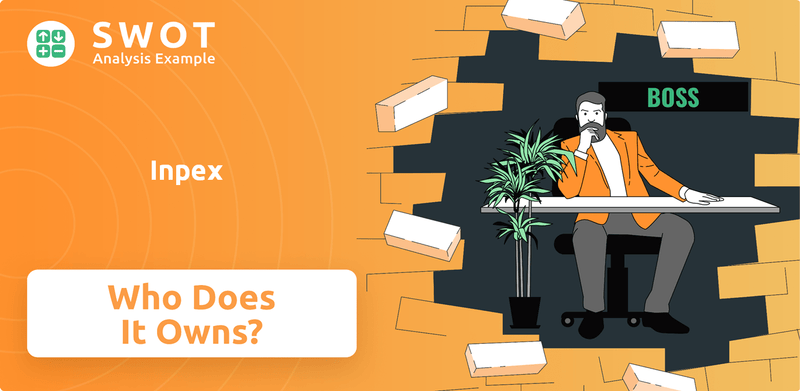
Understanding Inpex's shareholders and the Inpex parent company is vital for investors and analysts alike. This exploration of Inpex Japan will cover everything from Inpex stock ownership details to the identity of Inpex's major investors, providing a comprehensive view of the company's financial landscape. We'll examine how these stakeholders impact Inpex's financial performance and strategic decisions.
Who Founded Inpex?
The story of Inpex ownership begins in February 1966 with the establishment of North Sumatra Offshore Petroleum Exploration Co., Ltd. This marked the initial step toward independent development of overseas oil resources. While the exact founders and their initial equity aren't widely available, government involvement played a significant role in shaping the company's early structure.
When the company was listed on the Tokyo Stock Exchange on November 17, 2004, the Japan National Oil Corporation (JNOC), now part of the Japan Oil, Gas and Metals National Corporation (JOGMEC), held a substantial 53.96% stake. The Ministry of Economy, Trade and Industry (METI) also held a considerable 18.9% share, highlighting the strong governmental influence in the company's early years.
The merger with Teikoku Oil was a pivotal moment in Inpex corporation's history, orchestrated by the government. Teikoku Oil Co., Ltd., founded in 1941, was a semi-governmental entity created to consolidate existing Japanese oil exploration companies. This strategic move aimed to unify and strengthen Japan's oil and gas exploration efforts under a single entity, reflecting a national vision for energy security and resource development.
The initial formation of the company was geared towards independent development of overseas oil resources.
The government played a key role in the company's early ownership and strategic decisions.
The merger with Teikoku Oil was a strategic move towards a full integration, which was completed on October 1, 2008.
The company was listed on the Tokyo Stock Exchange on November 17, 2004.
JNOC held a significant stake, reflecting governmental influence.
The Ministry of Economy, Trade and Industry (METI) also held a considerable share.
The early ownership structure of Inpex Japan was heavily influenced by the Japanese government, aiming to secure energy resources and promote national interests. The merger with Teikoku Oil further consolidated these efforts, creating a unified entity to manage and develop oil and gas exploration projects. To understand more about how Inpex shareholders compare to other players in the industry, consider exploring the Competitors Landscape of Inpex.
- Early ownership was shaped by governmental bodies.
- JNOC and METI held significant stakes.
- The merger with Teikoku Oil was a strategic move.
- The company aimed to secure energy resources.
Inpex SWOT Analysis
- Complete SWOT Breakdown
- Fully Customizable
- Editable in Excel & Word
- Professional Formatting
- Investor-Ready Format
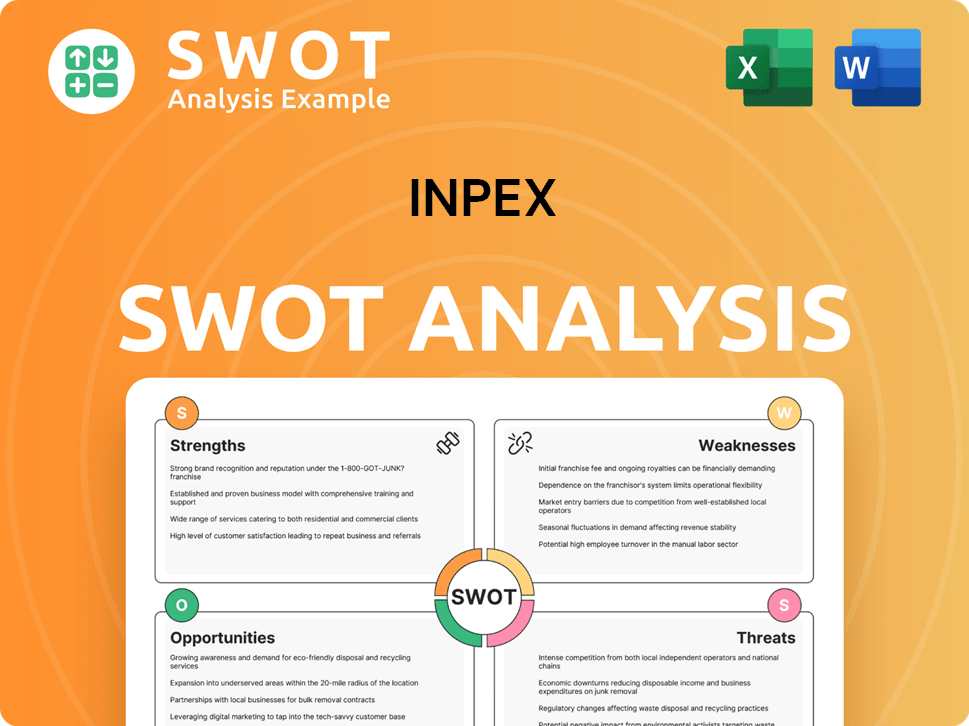
How Has Inpex’s Ownership Changed Over Time?
The evolution of Inpex's ownership reflects its growth from a government-backed entity to a publicly traded corporation. A pivotal moment was its listing on the Tokyo Stock Exchange on November 17, 2004. This transition marked a shift in the company's structure, opening it up to public and institutional investment and influencing its strategic direction. This change allowed for greater access to capital and increased market visibility, which are crucial for large-scale energy projects. The Marketing Strategy of Inpex has also evolved alongside these ownership changes.
The initial ownership structure saw the Japan National Oil Corporation (JNOC), later part of JOGMEC, holding a significant stake. The Ministry of Economy, Trade and Industry (METI) also held a considerable portion. These initial stakeholders played a crucial role in shaping the company's early strategies. Subsequent mergers and acquisitions further reshaped the ownership landscape, leading to the current diversified shareholder base.
| Key Dates | Event | Impact on Ownership |
|---|---|---|
| November 17, 2004 | Initial Public Offering (IPO) on the Tokyo Stock Exchange | Transition from primarily government-owned to publicly traded, opening up to institutional and individual investors. |
| Ongoing | Institutional Investment | Increased influence from institutional investors, shaping strategic direction and financial performance. |
| December 31, 2023 | Governmental Stake | The Minister of Economy, Trade and Industry remains a major shareholder, maintaining influence through veto rights. |
As of December 31, 2023, the Minister of Economy, Trade and Industry remains the largest shareholder, holding 21.99% of the shares. This governmental presence is significant, especially considering the veto rights the Minister holds. As of March 25, 2025, institutional investors collectively hold 43% of the company, with key players like BlackRock, Inc., and Nomura Asset Management Co., Ltd. The general public owns approximately 28% of the company. Public companies own 5.7% of the company.
Inpex ownership is a blend of governmental, institutional, and public shareholders. The Ministry of Economy, Trade and Industry is the largest shareholder. Institutional investors hold a substantial stake, influencing strategic decisions and financial performance.
- Governmental Stake: 21.99% (as of December 31, 2023)
- Institutional Investors: 43% (as of March 25, 2025)
- Public Ownership: Approximately 28% (as of March 25, 2025)
- Public Companies: 5.7% (as of March 25, 2025)
Inpex PESTLE Analysis
- Covers All 6 PESTLE Categories
- No Research Needed – Save Hours of Work
- Built by Experts, Trusted by Consultants
- Instant Download, Ready to Use
- 100% Editable, Fully Customizable
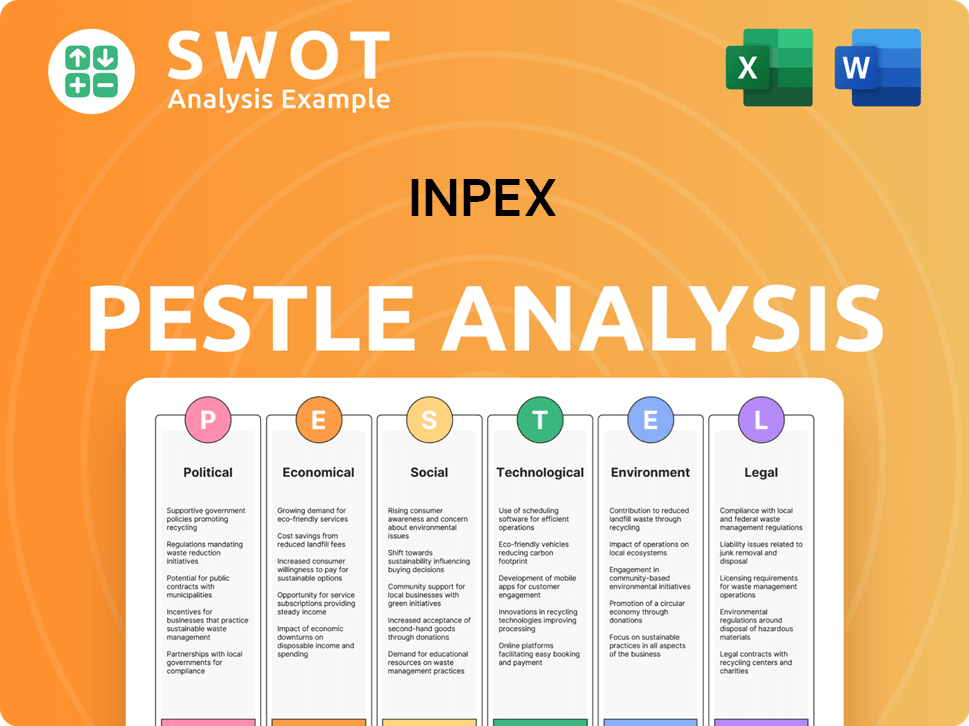
Who Sits on Inpex’s Board?
The Board of Directors at INPEX Corporation significantly influences the company's direction, with representation from both major shareholders and internal leadership. As of late 2024 and early 2025, key figures include Takayuki Ueda, serving as Chief Executive Officer, Director, and President. Other important board members include Toshiaki Takimoto, Hitoshi Okawa, Daisuke Yamada, and Kenji Kawano. These individuals oversee various aspects of the company's operations, including finance, net-zero initiatives, and project management.
The composition of the board reflects the governance structure of INPEX, which is closely tied to the strategic interests of Japan. The board's decisions are crucial for the company's performance and its ability to navigate the complexities of the global energy market. The influence of the Japanese government, as a major shareholder, is also a key factor in the company's strategic direction.
| Board Member | Title | Key Responsibilities |
|---|---|---|
| Takayuki Ueda | Chief Executive Officer, Director, President | Overall leadership and strategic direction |
| Toshiaki Takimoto | Director, Head - Net Zero Business, Senior Managing Executive Officer | Overseeing net-zero initiatives |
| Hitoshi Okawa | Director, Senior Managing Executive Officer, Senior Vice President - General Administration, Senior Vice President - Oceania Projects | Project management and administration |
| Daisuke Yamada | Senior Managing Executive Officer, Director, Senior Vice President - Finance & Accounting | Financial oversight |
| Kenji Kawano | Director, Senior Executive Vice President | Executive leadership |
The voting structure at INPEX is not a simple one-share-one-vote system. The Japanese government, through the Minister of Economy, Trade and Industry, holds a special class share, effectively giving it veto rights over certain critical decisions. As of December 31, 2023, the government held a 21.99% stake, underscoring its significant influence over the company. This arrangement reflects the strategic importance of INPEX to Japan's energy supply. For more insights into the Growth Strategy of Inpex, including its financial performance and future plans, refer to the provided resources.
Understanding Inpex ownership is crucial for investors and stakeholders. The board of directors, led by key figures like Takayuki Ueda, shapes the company's strategy.
- The Japanese government holds significant influence through a special class share.
- The board includes members overseeing finance, net-zero initiatives, and project management.
- The voting structure grants the government veto power over critical decisions.
- Inpex's strategic importance to Japan's energy supply is a key factor.
Inpex Business Model Canvas
- Complete 9-Block Business Model Canvas
- Effortlessly Communicate Your Business Strategy
- Investor-Ready BMC Format
- 100% Editable and Customizable
- Clear and Structured Layout
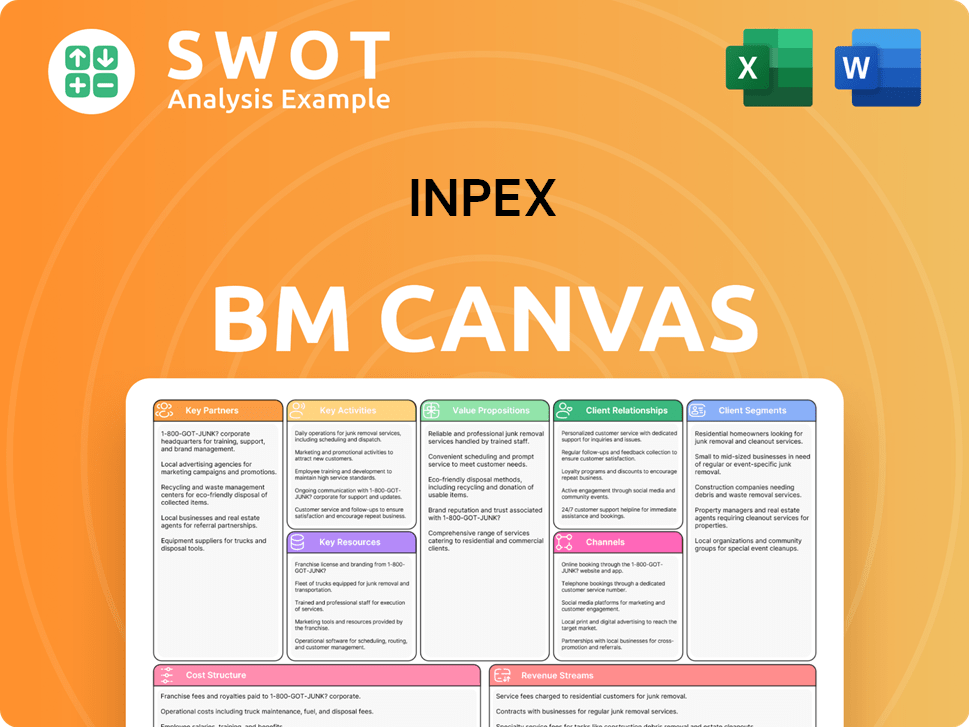
What Recent Changes Have Shaped Inpex’s Ownership Landscape?
Over the past three to five years, the ownership structure of the company has seen notable shifts. As of March 25, 2025, institutional investors held a significant 43% stake, indicating a sensitivity of the company's stock price to their trading activities. The Japanese government, through the Ministry of Economy, Trade and Industry, remains the largest single shareholder with 23% of outstanding shares as of March 25, 2025, maintaining a critical role in the company's governance.
The company has been involved in strategic portfolio adjustments. In 2023, Shell divested its 35% interest in the Abadi LNG project, with the company maintaining its position as the operator with a 65% stake. Further, the company completed the sale of a 42.5% participating interest in Block 2A offshore Malaysia to Seascape Energy, while retaining a 10% interest. Notably, there have been no new common stock issuances between 2020 and 2024.
| Ownership Category | Share Percentage (March 25, 2025) | Notes |
|---|---|---|
| Institutional Investors | 43% | Significant influence on stock price. |
| Japanese Government | 23% | Largest single shareholder; maintains governance role. |
| Other Shareholders | 34% | Includes various individual and corporate investors. |
The company's 'INPEX Vision 2035,' formulated in February 2025, reflects a strategic shift towards cleaner energy solutions, with a focus on lower-carbon initiatives such as Carbon Capture, Utilization, and Storage (CCUS) and hydrogen. The company aims to achieve a net-zero carbon society by 2050. Public statements highlight the company's plans to expand LNG production, projecting to reach 800,000 barrels of oil equivalent per day in the 2030s, up from the current 630,000 barrels. The Final Investment Decision (FID) for the Abadi LNG project is targeted by 2027, with production expected in the early 2030s. For the fiscal year ending December 31, 2024, the company reported a 4.7% increase in revenue, reaching ¥2,265.8 billion, and a 32.8% increase in profit attributable to owners of the parent, totaling ¥427.3 billion. For a deeper understanding, you can read a Brief History of Inpex.
Institutional investors hold a substantial portion of the company's shares, influencing stock performance. The Japanese government is a significant shareholder, ensuring governmental oversight. Strategic transactions and portfolio adjustments reflect the company's evolving focus.
The company reported increased revenue and profit in 2024. The company is focused on cleaner energy solutions. Expansion of LNG production is a key strategic goal.
The company's 'INPEX Vision 2035' emphasizes lower-carbon solutions. The company aims to achieve net-zero carbon emissions by 2050. The Abadi LNG project is a key focus.
The company anticipates challenging conditions in 2025 due to lower crude oil prices. Planned maintenance activities are also expected to impact operations. The company is focused on sustainable growth.
Inpex Porter's Five Forces Analysis
- Covers All 5 Competitive Forces in Detail
- Structured for Consultants, Students, and Founders
- 100% Editable in Microsoft Word & Excel
- Instant Digital Download – Use Immediately
- Compatible with Mac & PC – Fully Unlocked
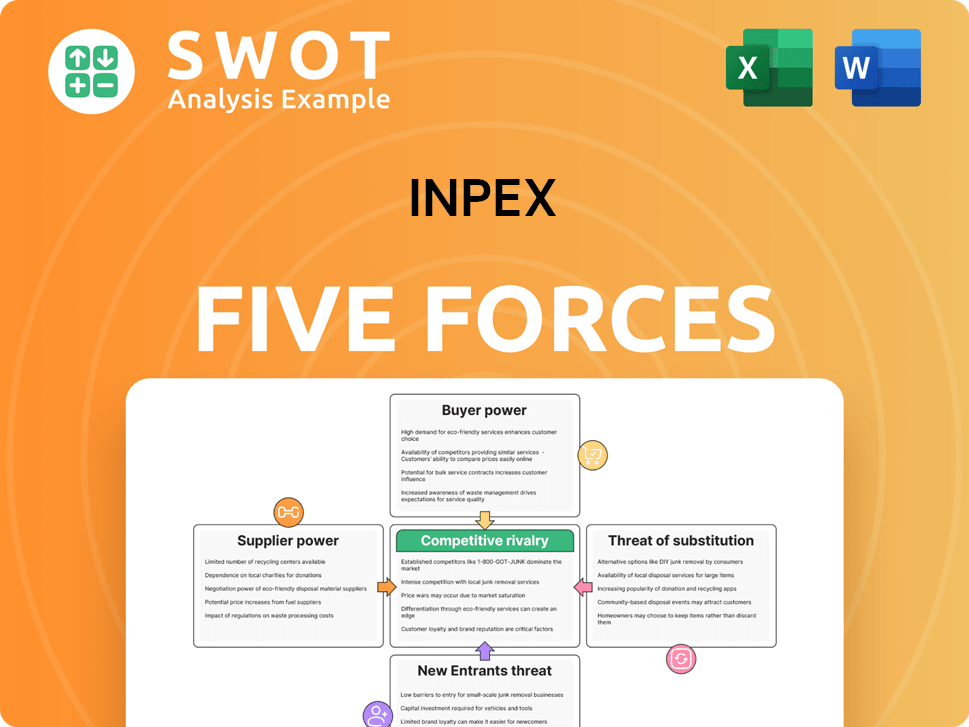
Related Blogs
- What are Mission Vision & Core Values of Inpex Company?
- What is Competitive Landscape of Inpex Company?
- What is Growth Strategy and Future Prospects of Inpex Company?
- How Does Inpex Company Work?
- What is Sales and Marketing Strategy of Inpex Company?
- What is Brief History of Inpex Company?
- What is Customer Demographics and Target Market of Inpex Company?
Disclaimer
All information, articles, and product details provided on this website are for general informational and educational purposes only. We do not claim any ownership over, nor do we intend to infringe upon, any trademarks, copyrights, logos, brand names, or other intellectual property mentioned or depicted on this site. Such intellectual property remains the property of its respective owners, and any references here are made solely for identification or informational purposes, without implying any affiliation, endorsement, or partnership.
We make no representations or warranties, express or implied, regarding the accuracy, completeness, or suitability of any content or products presented. Nothing on this website should be construed as legal, tax, investment, financial, medical, or other professional advice. In addition, no part of this site—including articles or product references—constitutes a solicitation, recommendation, endorsement, advertisement, or offer to buy or sell any securities, franchises, or other financial instruments, particularly in jurisdictions where such activity would be unlawful.
All content is of a general nature and may not address the specific circumstances of any individual or entity. It is not a substitute for professional advice or services. Any actions you take based on the information provided here are strictly at your own risk. You accept full responsibility for any decisions or outcomes arising from your use of this website and agree to release us from any liability in connection with your use of, or reliance upon, the content or products found herein.